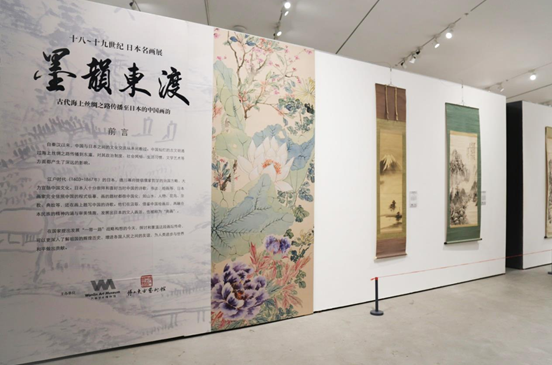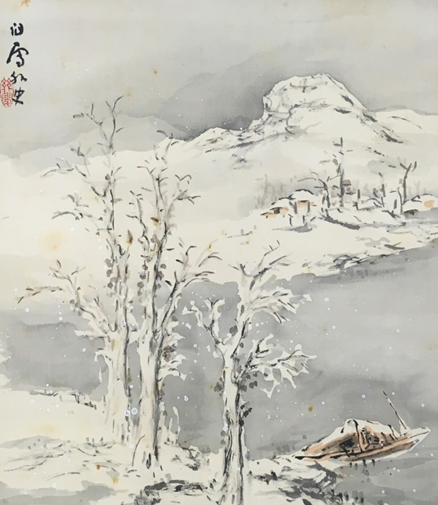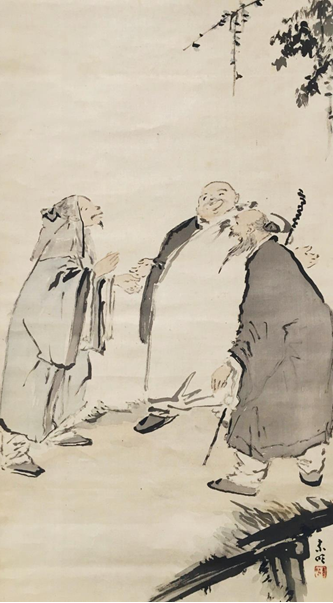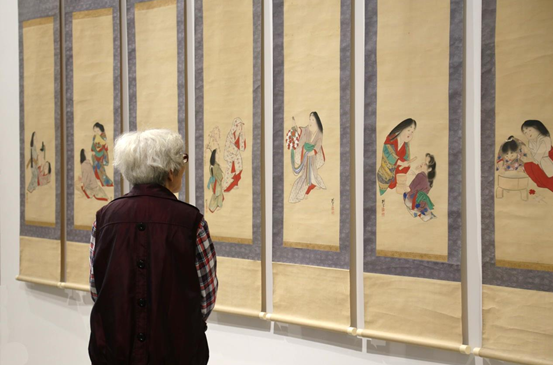From 18th May to 19th Jun, the exhibition of 18-19 century Japanese paintings, cosponsored by Wuhan University’s Wan Lin Art Museum and Hong Kong Broad Oriental art museum in Wan Lin Museum is on display. It includes over-100 literati works that are rich in themessuch as landscapes, figures, religions, legends, as well as bird-and-flower painting. There are .
Literati paintings that use black ink, were practiced by highly educated scholar gentlemen or literati in East Asia. The goal of literati painting is not simply to reproduce the appearance of the subject, but to capture its spirit. A bit like symbolism, many objects in the literati paintings have symbolic suggestion, most of which show direct moral appeals: high mountains and clouds imply an unsullied recluse, plum blossom in heavy snow shows a strong will, pine means eternity and diligence. Sometimes, the painter draws intellectuals or religious figures and their activities.

A glance at the entrance of the exhibition
Since the Qin Dynasty (BC221-BC207), cultural exchanges between Japan and China have never stopped. The ancient Chinese civilization spread to Japan through the Maritime Silk Road, and has had a significant influence on the political system, social customs, literature and art in Japan.
Tokugawa Shogunate, the government during Edo Period (1603-1867), made a great effort to advocate the Confucian philosophy as statecraft. The Japanese at that time worshiped Chinese poetry, calligraphy and painting. Pictures were drawn following the Chinese style, from its subject matter to drawing skills.Through imitation, the Japanese literati painting ---a blend of native spiritual connotation, aesthetic taste and Sinicism had developed.

Boat on the cold river, by Hashimoto Kansetsu(1883-1945)
Hashimoto was not only a painter, but also a Sinologist. In close association with many Chinese artists such as Pan Tianshou, Fu Baoshi, he visited China over thirty times since 1914.

Three laughing man at Huxi, by Yuuki Somei (1875-1957)
"Three laughing man” is a Chinese legend about a Confucian, a Buddhist monk and a Taoist’s acquaintances with each other, which is regarded as a reflection of Buddhism, Taoism and Confucianism’s fusion in China.
With an interpretation provided, the exhibition attracts many visitors, ranging from students, teachers, retired people, professional collectors to staff from the Hubei television station.

An old lady is watching Ōnishi Chinnen (1792-1851)’s painting.
Besides the elegant literati works, there are also some lively folk paintings. This series of paintings unfolds traditional Japanese female’s daily life.
"I thought it’s an exhibition of ukiyo-e (a kind of Japanese art)” said Miss Guan, a student who visited the museum after her Japanese history classes. “But it turned to be pretty Chinese.”
"Most of works on display were finished at the end of the Edo shogunate period, around the Meiji Restoration, when Japan opened its door and eastern culture conflicted with western culture. Nevertheless, you can’t see trace of that era in most of the paintings – they were like sleeping beauties lived in ancient China. I hope to see more traditional and native Japanese art next time, their unique styles of art.”
Miss Guo, a student from history school commented:“Look at the style, techniques, layout… obviously the paintings are quite similar to Chinese literati paintings, especially the landscape and bird-and-flower painting. Maybe it’s because the cultural exchange between China and Japan became increasingly frequent since Sui dynasty (AD581-AD618). They liked to draw Chinese historical celebrities, write Chinese preface and postscript and mount it after Chinese style”
Ancient China was once the center of the East Asian cultural circle and cultural exchanges color the same form of art in different countries diversely. I'm glad that we took a positive attitude to spread Chinese culture while absorbing the surrounding culture with an inclusive attitude. It’s because of this that the river of our civilization can run a long course, watering flowers of other civilizations in the world. So in the future we should hold the inclusive, eclectic attitude to actively promote mutual cultural exchanges.”
After all, this exhibition provided an access to learning foreign art. Across the east China sea, the aura of ink was spread from China to Japan, and now its brilliance attracts Chinese again, reminding us of a peaceful and open era.
(Edited by Mark & Hu Sijia)